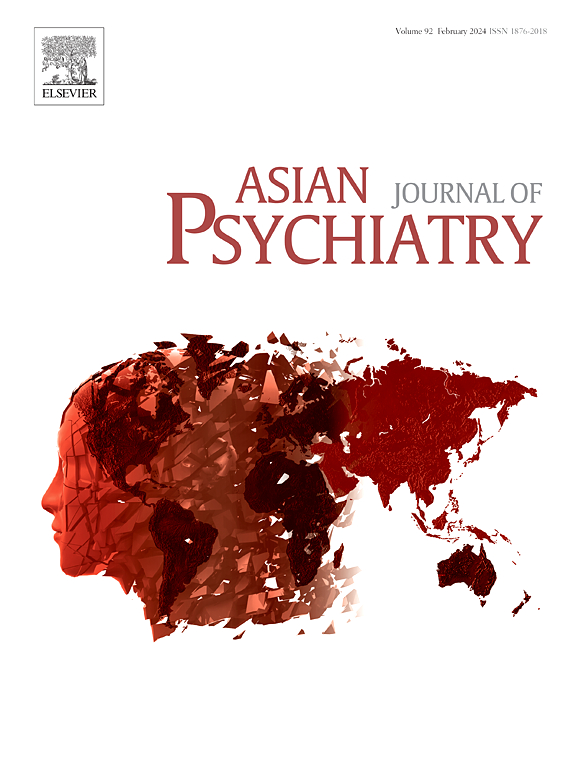Dose-effect trajectory of lumateperone in schizophrenia: Evidence from a systematic review and meta-analysis of randomized controlled trials
IF 3.8
4区 医学
Q1 PSYCHIATRY
引用次数: 0
Abstract
Background
The optimal dose of lumateperone for treating schizophrenia remains unclear. We examined its dose-response relationship for efficacy and acceptability.
Methods
We searched major databases (e.g. PubMed, EMBASE, Cochrane), and grey literature from inception to January 20, 2025 (INPLASY202510038) for randomized controlled trials (RCTs) comparing lumateperone with placebo in schizophrenia. We excluded non-peer-reviewed studies and those lacking a placebo group or involved non-schizophrenic patients. The Cochrane Risk of Bias Tool was used for risk of bias assessment. We used a one-step dose-response meta-analysis (DRMA) with a random-effects model to calculate the effect sizes as standardized mean differences (SMDs) and risk ratios (RRs) with 95 % confidence intervals (CIs).
Results
688 patients from two RCTs received placebo or lumateperone. Lumateperone 42 mg significantly improved the Positive and Negative Syndrome Scale (PANSS) total score (SMD = −0.29, 95 % CI: −0.47 to −0.10), PANSS positive symptom score (SMD = −0.41, 95 % CI: −0.64 to −0.18), and responder rate (RR = 1.52, 95 % CI: 1.16–2.01), as well as marginally improved the PANSS negative symptom score (SMD = −0.17, 95 % CI: −0.34–0.01). Higher doses (>42–63 mg) were associated with increased rates of oral dryness/thirst, nausea/vomiting, somnolence, and dizziness. No dose-response relationship was found for dropout rates, headache, or extrapyramidal symptoms. A limitation of this study is the small number of available RCTs.
Conclusions
Lumateperone 42 mg appears to offer the most favorable balance of efficacy and side effects for the treatment of schizophrenia.
lumateperone治疗精神分裂症的剂量-效应轨迹:来自随机对照试验的系统评价和荟萃分析的证据
背景:治疗精神分裂症的最佳剂量尚不清楚。我们检验了其疗效和可接受性的剂量-反应关系。方法:检索主要数据库(如PubMed、EMBASE、Cochrane)和2025年1月20日(INPLASY202510038)的灰色文献(灰色文献),比较lumateperone与安慰剂治疗精神分裂症的随机对照试验(rct)。我们排除了未经同行评议的研究、缺乏安慰剂组或涉及非精神分裂症患者的研究。采用Cochrane偏倚风险评估工具进行偏倚风险评估。我们采用一步剂量-反应荟萃分析(DRMA)和随机效应模型,以95% %置信区间(ci)计算标准化平均差异(SMDs)和风险比(rr)的效应大小。结果两项随机对照试验中688例患者接受安慰剂或氟哌酮治疗。Lumateperone 42 mg显著改善了阳性和阴性症状量表(PANSS)总分(SMD = - 0.29, 95 % CI: - 0.47至- 0.10)、PANSS阳性症状评分(SMD = - 0.41, 95 % CI: - 0.64至- 0.18)和应答率(RR = 1.52, 95 % CI: 1.16-2.01),并轻微改善了PANSS阴性症状评分(SMD = - 0.17, 95 % CI: - 0.34-0.01)。较高剂量(42-63 mg)与口腔干渴、恶心/呕吐、嗜睡和头晕的发生率增加相关。未发现辍学率、头痛或锥体外系症状的剂量-反应关系。本研究的一个局限性是可用的随机对照试验数量较少。结论舒坦哌酮42 mg在治疗精神分裂症的疗效和副作用方面具有较好的平衡。
本文章由计算机程序翻译,如有差异,请以英文原文为准。
求助全文
约1分钟内获得全文
求助全文
来源期刊

Asian journal of psychiatry
Medicine-Psychiatry and Mental Health
CiteScore
12.70
自引率
5.30%
发文量
297
审稿时长
35 days
期刊介绍:
The Asian Journal of Psychiatry serves as a comprehensive resource for psychiatrists, mental health clinicians, neurologists, physicians, mental health students, and policymakers. Its goal is to facilitate the exchange of research findings and clinical practices between Asia and the global community. The journal focuses on psychiatric research relevant to Asia, covering preclinical, clinical, service system, and policy development topics. It also highlights the socio-cultural diversity of the region in relation to mental health.
 求助内容:
求助内容: 应助结果提醒方式:
应助结果提醒方式:


